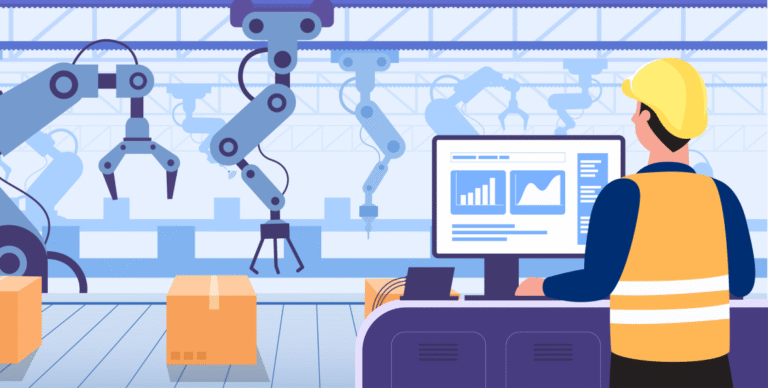This series of articles introduces the development trends of the Industrial Internet of Things (IIoT), focusing on the importance of the 'Edge Orchestration Platform' and how it addresses the challenges faced by current IIoT platforms. Finally, the articles present a practical case study to demonstrate how the Edge Orchestration Platform helps enterprises integrate OT and IT departments.
文/Rick Peng, eCloudEdge CEO
The Industrial Internet of Things (IIoT) refers to the connection of sensors, devices, and machinery through the internet to form an intelligent network, enabling the collection, transmission, analysis, and utilization of data. This technology is applied in industrial sectors to improve production efficiency, reduce costs, and optimize operational processes.
The predecessor of the Industrial Internet of Things (IIoT) – Industrial Automation
The history of industrial automation dates back to the mid-20th century, when mechanical control systems were gradually replaced by electronic control systems. During this period, automation systems primarily relied on Programmable Logic Controllers (PLCs) and Distributed Control Systems (DCS) to control industrial equipment. These systems communicated data through wired networks such as RS-232, RS-485, or other Fieldbus protocols, but remained relatively closed, lacking interoperability between systems.
By the end of the 20th century, the industry moved towards the SCADA stage. During this period, the development of Supervisory Control and Data Acquisition (SCADA) systems further advanced industrial automation. SCADA systems allowed for remote monitoring and control, enabling more efficient management and operations. However, SCADA was still confined to local networks, and most systems remained proprietary, making interoperability between equipment from different vendors difficult.
Modern Industrial Internet of Things (IIoT)
The concept of IIoT began to take shape in the early 21st century. With the development of internet and wireless communication technologies, the Internet of Things gradually found its application in the industrial sector. Today, with advancements in technologies such as 5G, artificial intelligence, and big data, the Industrial Internet of Things has further realized intelligent and data-driven business models. IIoT is widely applied across industries like manufacturing, energy, transportation, and healthcare. In manufacturing, IIoT is used for equipment monitoring, predictive maintenance, and production optimization. In the energy sector, IIoT enhances energy management efficiency and safety. In transportation, IIoT enables smart traffic management, rail transport safety, and logistics optimization.
The emergence of IIoT has accelerated the process of smart manufacturing and digital transformation. Factories and production lines are gradually evolving into smart factories. Through IIoT platforms and technologies, industrial equipment can autonomously collect data, perform real-time analysis, and improve decision-making quality and response speed, significantly reducing reliance on human labor. At this stage, artificial intelligence is also being gradually implemented in the field. While not yet ubiquitous, AI has started to make a significant impact in the industrial sector, further expanding the scope of IIoT applications. From equipment maintenance and energy consumption management to overall operational optimization, IIoT is now widely used across industrial sectors.
Security and interoperability have become key challenges in today's IIoT systems. As industrial systems are connected to the internet, the risk of cyberattacks increases, making the protection of data and systems a top priority. Additionally, since industrial equipment comes from different vendors, ensuring seamless interoperability between systems is another major challenge.
The Future of Industrial Internet of Things (IIoT)
The rapid advancements in AI technology are transforming the entire application of the Industrial Internet of Things (IIoT). The future of IIoT will move towards full intelligence and autonomy. With the further maturation of AI and deep learning technologies, industrial systems will be able to autonomously learn, adapt, and optimize production processes, leading to higher efficiency and precision.
Autonomous factories will become a reality, where equipment and systems will not only be interconnected but also collaborate to achieve full automation of the entire process from production planning to product delivery. Beyond the factory, AI-driven applications will increasingly emerge across industries such as transportation, energy, and retail. AI will fundamentally disrupt many industrial applications, bringing unexpected innovations to various sectors.
Edge computing, combined with high-speed communication, will play an increasingly important role in IIoT. As large amounts of data need to be processed in real-time on the factory floor, edge computing helps reduce data transmission delays and enhances system response speed. The introduction of 5G technology will accelerate the adoption of IIoT. With its high-speed and low-latency features, 5G will support more simultaneous device connections and enable more instantaneous data communication, further advancing industrial automation.
Edge computing is a crucial component of IIoT, shifting data processing capabilities from centralized cloud services to locations closer to the data source. This reduces latency and enhances response speed. Edge devices, including sensors, IoT gateways, and edge servers, are capable of performing real-time analysis and preprocessing at the point of data generation, reducing the burden of data transmission and improving the overall system efficiency.
The past decade has been a golden era for the development of cloud services, with many cloud service providers and SaaS software vendors emerging rapidly in the market, and businesses becoming more willing to embrace cloud solutions. However, with the evolution of cloud technology and increasing user demands, the traditional single-cloud architecture has gradually shifted towards a multi-cloud and hybrid cloud architecture. Moreover, cloud computing is unable to meet the real-time demands at the edge.
As a result, cloud-edge collaboration will become the mainstream trend in the market. By leveraging the flexible nature of cloud computing, it offers scalable planning and continuous computing power. When combined with edge hardware platforms, it meets the real-time response needs at the edge, establishing a cloud-edge collaboration framework. Cloud integration involves deeper analysis and storage of the data collected at the edge. Cloud platforms provide powerful computing resources and advanced analytical tools to process large amounts of data and extract valuable insights. Through the cloud, businesses can achieve cross-regional and cross-departmental data collaboration, enabling a more comprehensive optimization of production processes and decision-making.
The Industrial Internet of Things (IIoT) enables a groundbreaking revolution in industrial processes through data collaboration from the edge to the cloud. This article explores the challenges faced in managing complex data flows within the IIoT domain, from the intricacies of edge computing to seamless cloud integration, which are crucial for unlocking the potential of digital transformation. As the industry embraces the Industrial Revolution 4.0, data collaboration from edge to cloud has become a key driving force. IIoT is composed of countless sensors, devices, and machines, requiring seamless data flow and security to enhance decision-making quality and operational efficiency. However, some manufacturers still harbor concerns about cloud services. It is hoped that through this article, a deeper understanding of cloud services will be gained, and that, in the future, they will be able to embrace cloud solutions.
Challenges Facing the Industrial Internet of Things (IIoT)
The rise of the Industrial Internet of Things (IIoT) has opened a new chapter. In the past, communication on industrial sites relied on proprietary communication protocols, closed network architectures, and non-encrypted data transmission. However, with the advent of connected devices in industrial environments, the existing infrastructures and frameworks are facing significant challenges. This article will guide readers in exploring the differences between IIoT and traditional IoT, delve into the current challenges faced by IIoT, and ultimately highlight the importance of data governance, as well as its connection between OT (Operational Technology) and IT. The goal is to provide readers with a deeper understanding of IIoT, encouraging them to think about how businesses can respond to and plan for dual-axis transformation.
The Differences Between Industrial Internet of Things (IIoT) and Traditional Internet of Things (IoT)
The Industrial Internet of Things (IIoT) and Traditional Internet of Things (IoT) differ significantly in many aspects. Below is a comparison in terms of system stability, real-time requirements, system architecture, and security:
- System Stability
- IIoT: Stability is crucial, as any failure could lead to production downtime or equipment damage. IIoT systems require highly reliable hardware and software, with some critical infrastructures even implementing redundant systems and stringent fault-tolerant mechanisms to ensure long-term stable operation.
- IoT: Compared to IIoT, the stability requirements are lower. Consumer-grade IoT devices, such as smart home products, can tolerate occasional failures without causing severe consequences.
- Real-Time Capability
- IIoT: Real-time requirements are extremely high, especially in manufacturing and automation processes. Data must be collected, processed, and fed back in real-time to enable precise control and rapid response.
- IoT:Real-time requirements are lower. For typical smart home and consumer-grade applications, a few seconds of delay usually does not affect the user experience.
- System Architecture
- IIoT: The system architecture is typically more complex, involving the integration of sensors, edge devices, gateways, cloud platforms, and enterprise systems. These systems need to handle large volumes of data and seamlessly integrate with existing industrial control systems (such as SCADA and DCS).
- IoT: The system architecture is relatively simple, primarily consisting of sensors, gateways, and cloud platforms. The data volume is smaller, and processing requirements are lower, with a primary focus on connectivity and ease of application.
- Security
- IIoT: Security is a top priority, as industrial systems often involve critical infrastructure and production processes. Multi-layered security protection is required, including network security, device security, data security, and operational security. Additionally, compliance and regulatory requirements are more stringent.
- IoT: Security is still important, but the risks are lower. Consumer-grade IoT devices typically only require basic network and data protection measures. While they may face privacy and data leakage risks, the impact is generally minimal.
- Data Processing and Analytics
- IIoT: Requires processing large amounts of real-time data and performing complex analytics to optimize operations and equipment maintenance. For example, many industries such as manufacturing and transportation are already heavily using artificial intelligence and machine learning technologies for predictive maintenance and operational optimization.
- IoT: Data processing volume is smaller, and analytics requirements are simpler. The focus is mainly on enhancing user experience and simplifying daily operations, such as automation control and status monitoring in smart homes.
- Scale and Cost
- IIoT: The scale is typically larger, involving a significant number of devices and complex system integration, resulting in high initial investment and operational costs. Maintenance and upgrade costs are also higher.
- IoT: The scale is smaller, with relatively lower deployment and operational costs. Consumer-grade IoT devices are typically inexpensive, easy to install, and simple to use.
Overall, Industrial Internet of Things (IIoT) has higher requirements in terms of stability, real-time capabilities, system architecture, and security compared to traditional Internet of Things (IoT). This is due to the specific application environments and user demands. IIoT involves critical infrastructure and production processes, requiring highly reliable and real-time data processing, as well as multi-layered security protection, while traditional IoT focuses more on convenience and ease of use for consumer applications.



